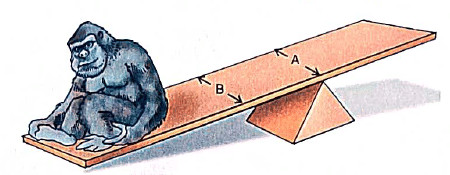Textbook Solutions: Simple Machine | Eureka Plus Class 5: Book Solutions, Notes & Worksheets PDF Download
I. Give one word for each of the following:
Q1: a push or a pull ______________
Ans: Force
Q2: a grooved wheel with a rope around it ______________
Ans: Pulley
Q3: a machine that has multiple pulleys ______________
Ans: Crane
Q4: the point that supports a lever ______________
Ans: Fulcrum
Q5: the class of levers a nutcracker belongs to ______________
Ans: second-class levers
II. Answer the following questions in one sentence.
Q1: What is energy?
Ans: Energy is the ability to do work.
Q2: What can force do?
Ans: Force can move an object, stop a moving object, or change the direction of a moving object.
Q3: When is energy used?
Ans: Energy is used when force is applied to move an object.
Q4: When Is the work done?
Ans: Work is done when an object moves by applying force.
Q5: What is a complex machine made up of?
Ans: A complex machine is made up of two or more simple machines.
III. Do as directed.
Q1: Write what is meant by a machine. Describe briefly the six types of simple machines.
Ans: Machine: A machine is a device used to make work easier. It helps us do work with less effort.
Types of Simple Machines:
- Inclined Plane: A flat, slanting surface that makes it easier to move objects up or down (e.g., ramp, slide).
- Screw: A simple machine with an inclined plane wound around a cylinder (e.g., screw, bolt).
- Wedge: A tool with a sharp edge used to cut or split objects (e.g., knife, axe).
- Wheel and Axle: A wheel attached to a rod (axle) that helps move objects with less effort (e.g., bicycle, fan).
- Pulley: A grooved wheel with a rope or cable around it, used to lift or move objects (e.g., crane, flagpole).
- Lever: A bar that pivots around a fixed point (fulcrum) to lift or move objects (e.g., seesaw, bottle opener).
IV. Describe each of the following simple machines in three to four sentences:
1. Screw
Ans: A screw is an inclined plane wound around a cylinder. It is used to hold things together or lift objects. When you twist a screw, it moves through an object and secures it tightly. Examples include the screws used in construction or the lid of a jar.
2. Wedge
Ans: A wedge is a tool with at least one slanting side that forms a sharp edge. It is used to cut, split, or join objects. The slanting edge of the wedge helps it to apply force over a smaller area, making it easier to cut or split things. Examples include a knife, axe, or needle.
3. Wheel and Axle
Ans: The wheel and axle is a simple machine that consists of a wheel attached to a rod (axle) in the center. When the wheel moves, the axle moves too, and it helps in moving heavy objects with less effort. This system is used in many machines like bicycles, fans, and even vehicles.
4. Lever
Ans: A lever is a stiff bar that moves around a fixed point called the fulcrum. There are three classes of levers depending on the position of the load, fulcrum, and effort. A lever is used to lift or move heavy objects by applying less force. Examples include a seesaw, bottle opener, or crowbar.
5. Pulley
Ans: A pulley is a grooved wheel with a rope or cable around it. It is used to lift or move heavy loads by changing the direction of the force applied. When the rope is pulled down, the load is lifted up. Examples include cranes, flagpoles, or water wells.
Higher Order Thinking Skills
I. Study each case and answer the questions that follow
Case 1 Rocks from near the tree were first moved onto the logs one by one. Three men then pushed each rock close to the two large rocks. The logs work like a wheel and axle and help move the rocks. The rocks were tied to a strong rope one by one. Then 15 men pulled up each rock and placed them on top of the two large rocks.
Case 2 Rocks from near the tree were first moved onto the logs one by one. Three men then pushed each rock over a sloping surface and placed it on the top of the two large rocks
Q1: Why were wooden logs used to move the rocks?
Ans: Wooden logs were used to move the rocks because they function as a type of simple machine called a wheel and axle. This allows the rocks to be moved with less friction and effort. The logs act as rollers, making it easier to transport the heavy rocks across a surface.
Q2: In the first case, how many men pulled each rock up and placed it on the two large rocks?
Ans: In the first case, 15 men pulled each rock up and placed it on top of the two large rocks.
Q3: In the second case, which two types of simple machines did the men use to shift the rocks?
Ans: In the second case, the men used logs (acting as a wheel and axle) and a ramp or inclined plane. The logs helped move the rocks, while the sloping surface allowed the rocks to be pushed up with less effort.
Q4: In which case were the rocks shifted from near the tree to the top of the two large rocks with less effort? Why?
Ans: The rocks were shifted with less effort in the second case. This is because the use of the sloping surface (inclined plane) reduced the force needed to lift the rocks. Instead of lifting them directly, the ramp allowed the rocks to be moved upward more gradually, requiring less force compared to pulling them up vertically as in the first case.
II. Study the following illustration and answer the questions. Q1: On what type of machine is the gorilla sitting?
Q1: On what type of machine is the gorilla sitting?
Ans: The gorilla is sitting on a simple machine (a lever).
Q2: Mark the region where force should be applied to raise the load.
Ans: Force should be applied at the effort point.
Q3: When the fulcrum is placed at 'A', 10 adults are needed to move the gorilla. How many adults will be able to move the gorilla if the fulcrum is placed at 'B'?
Ans: Less than 10 adults will be needed when the fulcrum is at 'B'.
Q4: What type of lever is it?
Ans: It is a third-class lever.
FAQs on Textbook Solutions: Simple Machine - Eureka Plus Class 5: Book Solutions, Notes & Worksheets
| 1. What are simple machines and why are they important? |  |
| 2. Can you name the six types of simple machines? |  |
| 3. How does a lever work? |  |
| 4. What is an example of a pulley in everyday life? |  |
| 5. How does an inclined plane help us? |  |
















